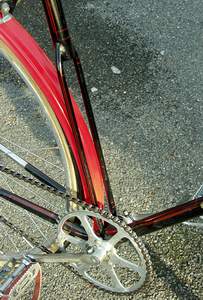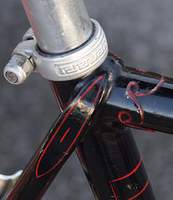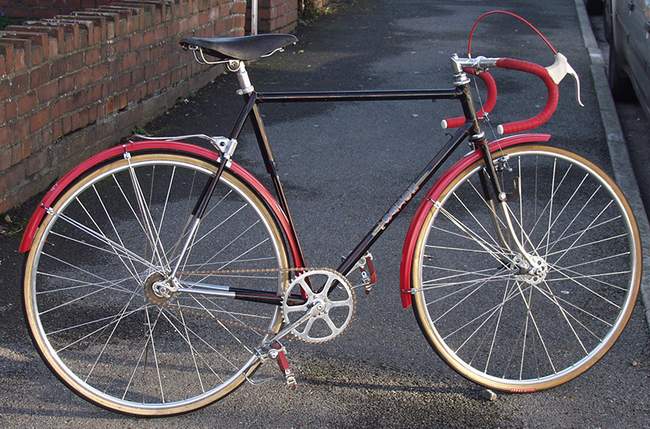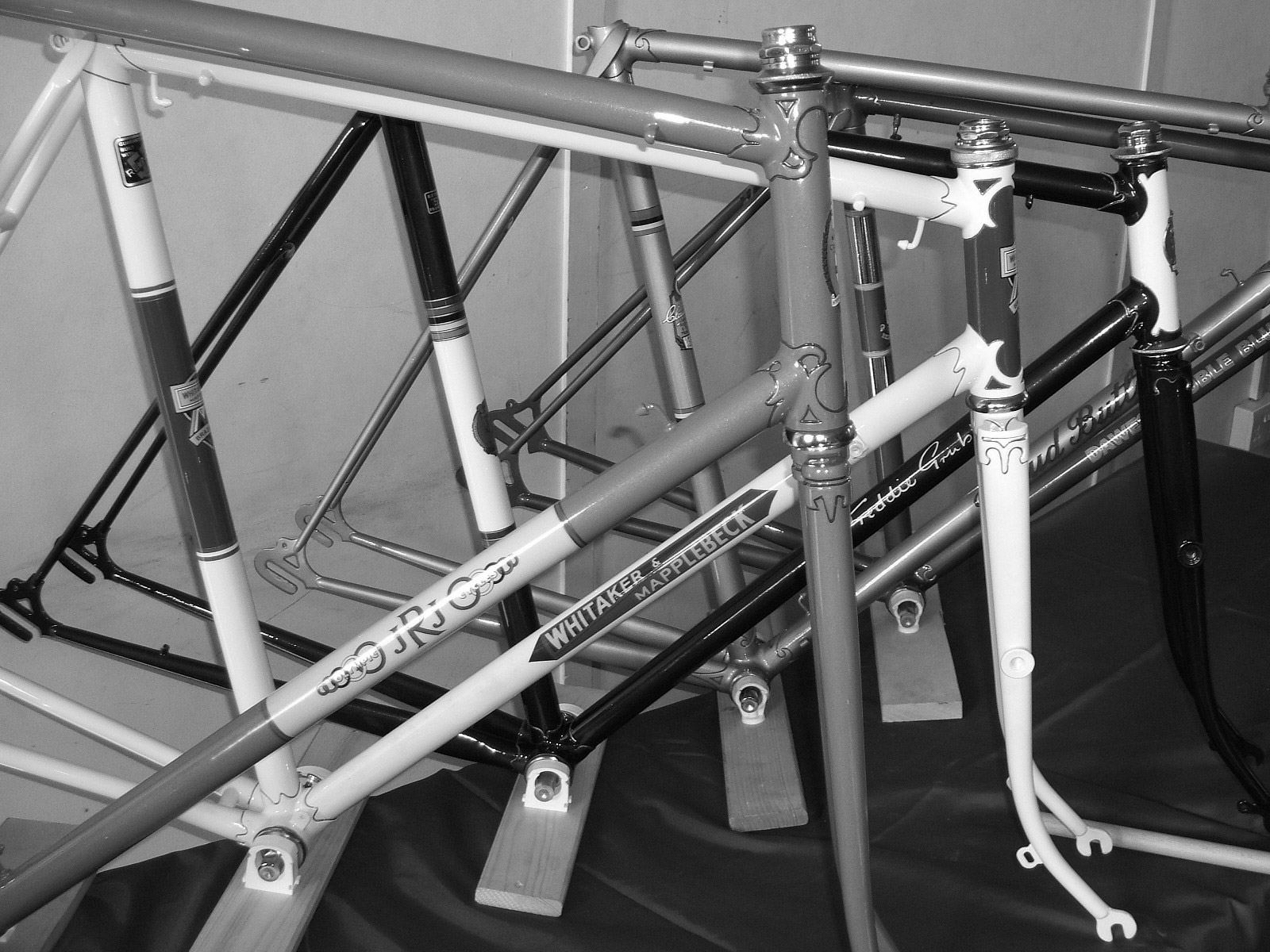Saxon Twin-tube
Posted: Wednesday 12th August 2020
The 1930s In Britain was a period of fairly rapid change in lightweight bicycle design. A lot of attention was paid to improving the efficiency of the bike. Cycling magazine at the time devoted many pages to writers (many of whom had little real knowledge) espousing different ways in which the rider’s power might be better transmitted to making the bike go faster.
One of the common themes was that a stiffer frame wasted less of a rider’s energy. One way frequently advanced was to shorten the wheelbase. There is no doubt that shorter tubes are stiffer than otherwise identical longer ones and that is why small frames offer increased stiffness. Out of this desire for a stiffer and supposedly more responsive and faster frame came a few quite unorthodox frame designs.
In another Design classic we have looked at the Baines Flying Gate frame design which reduced the length of the chainstays. The Saxon Twin tube came out of the same belief – shortening the chainstays will stiffen the bottom bracket against flexing under the power of the rider pedalling and will lead to less energy being lost.
Saxon was not quite the typical small lightweight frame builder. Founded in 1919 in East London it was a company on similar lines to Sun making a full range of bikes including roadsters. Keen cyclists in the 20s or 30s inevitably belonged to a cycling club. Money was short for many of these riders and whilst Hercules and Raleigh built suitable machines these were looked down upon. Hence Saxon catered for those who needed a well respected, budget machine. In the years 1937–1939 Saxon was producing about 3000 machines a year according to the testimony of a former employee – more than most lightweight framebuilders.
But back to the twin-tube design – one of the difficulties of radically shortening the chainstays is that the rear wheel will soon rub on the seat tube. Saxon took an approach tried before in the 1890s and replaced the conventional seat tube by two smaller diameter ones brazed close the outer edges of the bottom bracket shell and allowing the wheel to run almost between them.

However this is to jump one step too ahead too quickly. Tandem frames did have serious flexing problems – and as we have seen in a previous Design Classic Claud Butler with the SWB tandem and curved seat tube attempted to make a stiffer frame. Saxon first applied the idea of twin seat tubes to their ‘Wings of the Wind’ tandem design which appeared first in 1937.
Saxon‘s solo machine with the twin seat tubes had as standard a 38in wheelbase with chainstays just over 14in long. It was offered in three models – TT Road Race, Twin-Tube Path and Paramount which was their top model. They made great play of the fact that their design allowed the front-end geometry of the bike to remain unaltered yet still achieve a wheelbase three inches shorter than standard. These were reasonably popular machines – they ride surprisingly nicely – some appear to have a tendency to crack the seat lug which is subjected to greater stresses than normal – but the outbreak of World War Two stopped production.

The Saxon name was sold to Claud Butler during the war and in 1950 Claud Butler introduced a new version of the twin tube under the Saxon name. This time a short length of normal seat tube was used at the top with the twin seat tubes joined to it at their top end (see image right). The new frame was also built lugless unlike the original although it could be had optionally with the All-Rounder bilaminations at extra cost. But like the original it only lasted in the catalogues for a couple of years. Since then several other manufacturers have tried the twin seat tube design but the disadvantages – primarily these days the short chainstays – interfere with the proper working of the derailleur gear.
Thanks to John Wheatley for the Saxon featured and Dudley Cheal and Ben Sharp for additional information. Ben Sharp is the Veteran-Cycle Club’s Marque Enthusiast for Saxon and would welcome details or information on Saxon cycles. He can be contacted 01797 227687. or email zogware(at)hotmail.com – substitute @ for (at)
Equipment
The top end Paramount model featured the very best in equipment available – Duprat hollow steel octagonal cranks, Mansfield Ormonde saddle with aluminium frame, Gloria aluminium calliper brakes and Simplex Champion du Monde derailleur. The standard model was not offered a gear as standard – like most bikes of the time it was supplied with two fixed sprockets.
Frame Materials
Saxon described the tubing as ‘Chrome-molybdenum’. This was probably standard off the peg alloy steel tubing and was probably not Accles and Pollocks Kromo as it would have been mentioned by name. The frames were not especially light – some feel distinctly heavy.

Forks and Front end frame geometry
Frame angles steepened during the 1930s and the head tube angle on the twin tubes was normally about 72° with a much larger fork offset than is commonly used today – 2 ½in (64mm). Fork blade shape was a pattern specific to Saxon’s with the offset largely in the bottom third of the fork blade length – similar to, but different from, the Russ blade where the offset was closer to the bottom of the fork blade. The typically large fork offset made for a quite small amount of trail which did nothing for the high speed stability. The one featured has about 3in of fork offset which is larger than normal.
Frame Type
Road racing was still fairly unusual in Britain in the late 1930s and the Twin-tube design was really aimed at the club rider who was also a time triallist. However it was also perfectly being capable of being used with 26in wheels and mudguards for club riding. 27in wheels were fairly new and could be fitted even with the ultra short chainstays but without guards. A version with rearward facing rear dropouts was built for track use.
Posted: Wednesday 12th August 2020
This article appears in the following categories.
Upcoming Events
Whether you are looking for a gentle social meet up, or a 100-mile ride browse the community’s upcoming events and plan your next weekend outing.
